Leadership and Operational Management: Theories and Application
VerifiedAdded on 2024/05/23
|25
|5567
|102
Report
AI Summary
This report provides a detailed analysis of leadership and management roles, comparing their characteristics and functions within an organizational context, using Toyota Plc as an example. It examines the application of various leadership theories, including classical, behavioral, situational, systems, and contingency approaches, to real-world scenarios. The report assesses the strengths and weaknesses of different management approaches, such as Six Sigma and Total Quality Management, and evaluates their impact on operational efficiency and business objectives. Furthermore, it explores the key approaches to operations management, the role of leaders and managers in achieving business goals, and the factors within the business environment that influence operational management and decision-making, with specific reference to Amazon. The report concludes by critically evaluating the application of operations management and its broader impact on the business environment and community.
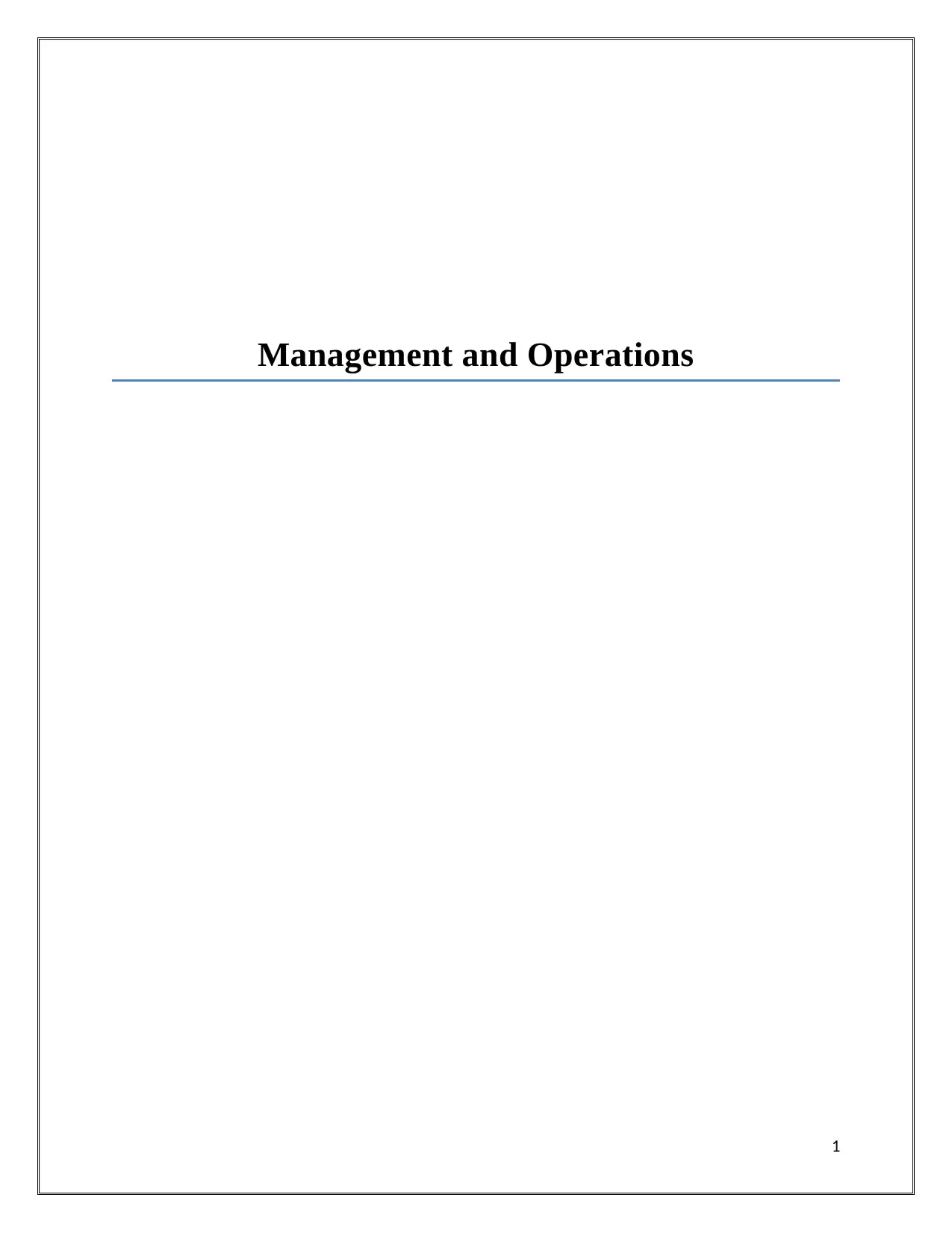
Management and Operations
1
1
Paraphrase This Document
Need a fresh take? Get an instant paraphrase of this document with our AI Paraphraser
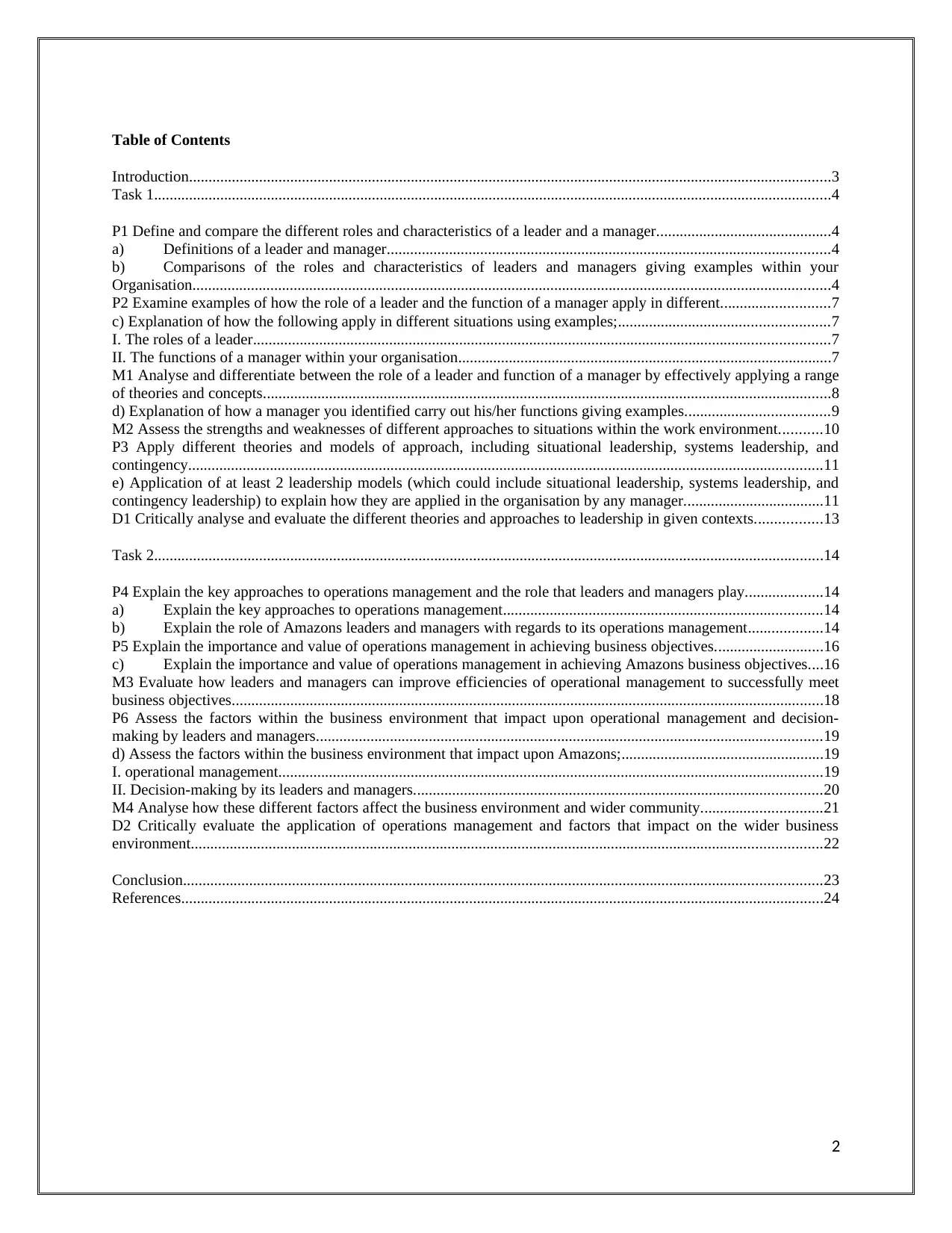
Table of Contents
Introduction.....................................................................................................................................................................3
Task 1..............................................................................................................................................................................4
P1 Define and compare the different roles and characteristics of a leader and a manager.............................................4
a) Definitions of a leader and manager..................................................................................................................4
b) Comparisons of the roles and characteristics of leaders and managers giving examples within your
Organisation....................................................................................................................................................................4
P2 Examine examples of how the role of a leader and the function of a manager apply in different............................7
c) Explanation of how the following apply in different situations using examples;......................................................7
I. The roles of a leader....................................................................................................................................................7
II. The functions of a manager within your organisation................................................................................................7
M1 Analyse and differentiate between the role of a leader and function of a manager by effectively applying a range
of theories and concepts..................................................................................................................................................8
d) Explanation of how a manager you identified carry out his/her functions giving examples.....................................9
M2 Assess the strengths and weaknesses of different approaches to situations within the work environment...........10
P3 Apply different theories and models of approach, including situational leadership, systems leadership, and
contingency...................................................................................................................................................................11
e) Application of at least 2 leadership models (which could include situational leadership, systems leadership, and
contingency leadership) to explain how they are applied in the organisation by any manager....................................11
D1 Critically analyse and evaluate the different theories and approaches to leadership in given contexts.................13
Task 2............................................................................................................................................................................14
P4 Explain the key approaches to operations management and the role that leaders and managers play....................14
a) Explain the key approaches to operations management..................................................................................14
b) Explain the role of Amazons leaders and managers with regards to its operations management...................14
P5 Explain the importance and value of operations management in achieving business objectives............................16
c) Explain the importance and value of operations management in achieving Amazons business objectives....16
M3 Evaluate how leaders and managers can improve efficiencies of operational management to successfully meet
business objectives........................................................................................................................................................18
P6 Assess the factors within the business environment that impact upon operational management and decision-
making by leaders and managers..................................................................................................................................19
d) Assess the factors within the business environment that impact upon Amazons;....................................................19
I. operational management............................................................................................................................................19
II. Decision-making by its leaders and managers.........................................................................................................20
M4 Analyse how these different factors affect the business environment and wider community...............................21
D2 Critically evaluate the application of operations management and factors that impact on the wider business
environment..................................................................................................................................................................22
Conclusion....................................................................................................................................................................23
References.....................................................................................................................................................................24
2
Introduction.....................................................................................................................................................................3
Task 1..............................................................................................................................................................................4
P1 Define and compare the different roles and characteristics of a leader and a manager.............................................4
a) Definitions of a leader and manager..................................................................................................................4
b) Comparisons of the roles and characteristics of leaders and managers giving examples within your
Organisation....................................................................................................................................................................4
P2 Examine examples of how the role of a leader and the function of a manager apply in different............................7
c) Explanation of how the following apply in different situations using examples;......................................................7
I. The roles of a leader....................................................................................................................................................7
II. The functions of a manager within your organisation................................................................................................7
M1 Analyse and differentiate between the role of a leader and function of a manager by effectively applying a range
of theories and concepts..................................................................................................................................................8
d) Explanation of how a manager you identified carry out his/her functions giving examples.....................................9
M2 Assess the strengths and weaknesses of different approaches to situations within the work environment...........10
P3 Apply different theories and models of approach, including situational leadership, systems leadership, and
contingency...................................................................................................................................................................11
e) Application of at least 2 leadership models (which could include situational leadership, systems leadership, and
contingency leadership) to explain how they are applied in the organisation by any manager....................................11
D1 Critically analyse and evaluate the different theories and approaches to leadership in given contexts.................13
Task 2............................................................................................................................................................................14
P4 Explain the key approaches to operations management and the role that leaders and managers play....................14
a) Explain the key approaches to operations management..................................................................................14
b) Explain the role of Amazons leaders and managers with regards to its operations management...................14
P5 Explain the importance and value of operations management in achieving business objectives............................16
c) Explain the importance and value of operations management in achieving Amazons business objectives....16
M3 Evaluate how leaders and managers can improve efficiencies of operational management to successfully meet
business objectives........................................................................................................................................................18
P6 Assess the factors within the business environment that impact upon operational management and decision-
making by leaders and managers..................................................................................................................................19
d) Assess the factors within the business environment that impact upon Amazons;....................................................19
I. operational management............................................................................................................................................19
II. Decision-making by its leaders and managers.........................................................................................................20
M4 Analyse how these different factors affect the business environment and wider community...............................21
D2 Critically evaluate the application of operations management and factors that impact on the wider business
environment..................................................................................................................................................................22
Conclusion....................................................................................................................................................................23
References.....................................................................................................................................................................24
2
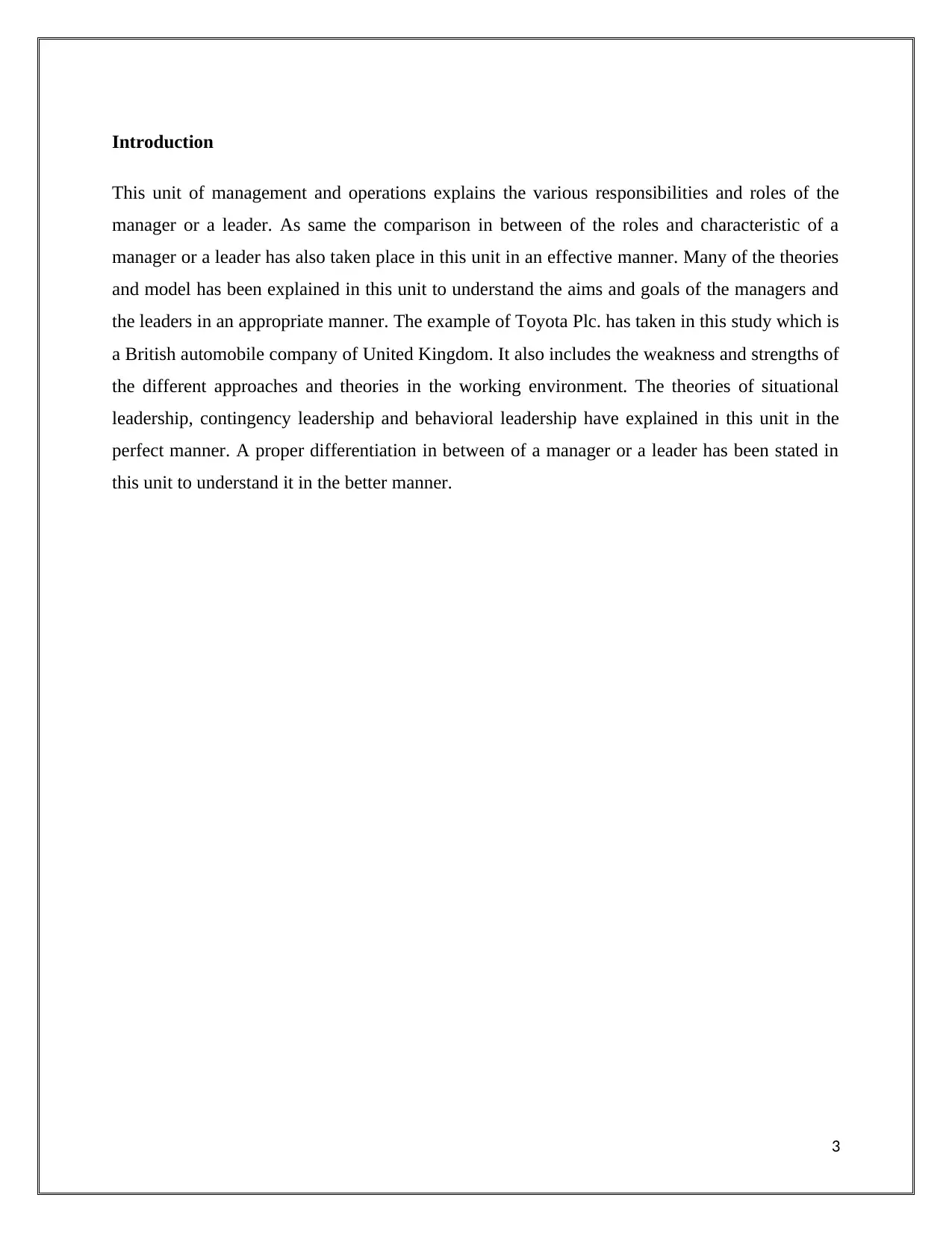
Introduction
This unit of management and operations explains the various responsibilities and roles of the
manager or a leader. As same the comparison in between of the roles and characteristic of a
manager or a leader has also taken place in this unit in an effective manner. Many of the theories
and model has been explained in this unit to understand the aims and goals of the managers and
the leaders in an appropriate manner. The example of Toyota Plc. has taken in this study which is
a British automobile company of United Kingdom. It also includes the weakness and strengths of
the different approaches and theories in the working environment. The theories of situational
leadership, contingency leadership and behavioral leadership have explained in this unit in the
perfect manner. A proper differentiation in between of a manager or a leader has been stated in
this unit to understand it in the better manner.
3
This unit of management and operations explains the various responsibilities and roles of the
manager or a leader. As same the comparison in between of the roles and characteristic of a
manager or a leader has also taken place in this unit in an effective manner. Many of the theories
and model has been explained in this unit to understand the aims and goals of the managers and
the leaders in an appropriate manner. The example of Toyota Plc. has taken in this study which is
a British automobile company of United Kingdom. It also includes the weakness and strengths of
the different approaches and theories in the working environment. The theories of situational
leadership, contingency leadership and behavioral leadership have explained in this unit in the
perfect manner. A proper differentiation in between of a manager or a leader has been stated in
this unit to understand it in the better manner.
3
⊘ This is a preview!⊘
Do you want full access?
Subscribe today to unlock all pages.

Trusted by 1+ million students worldwide
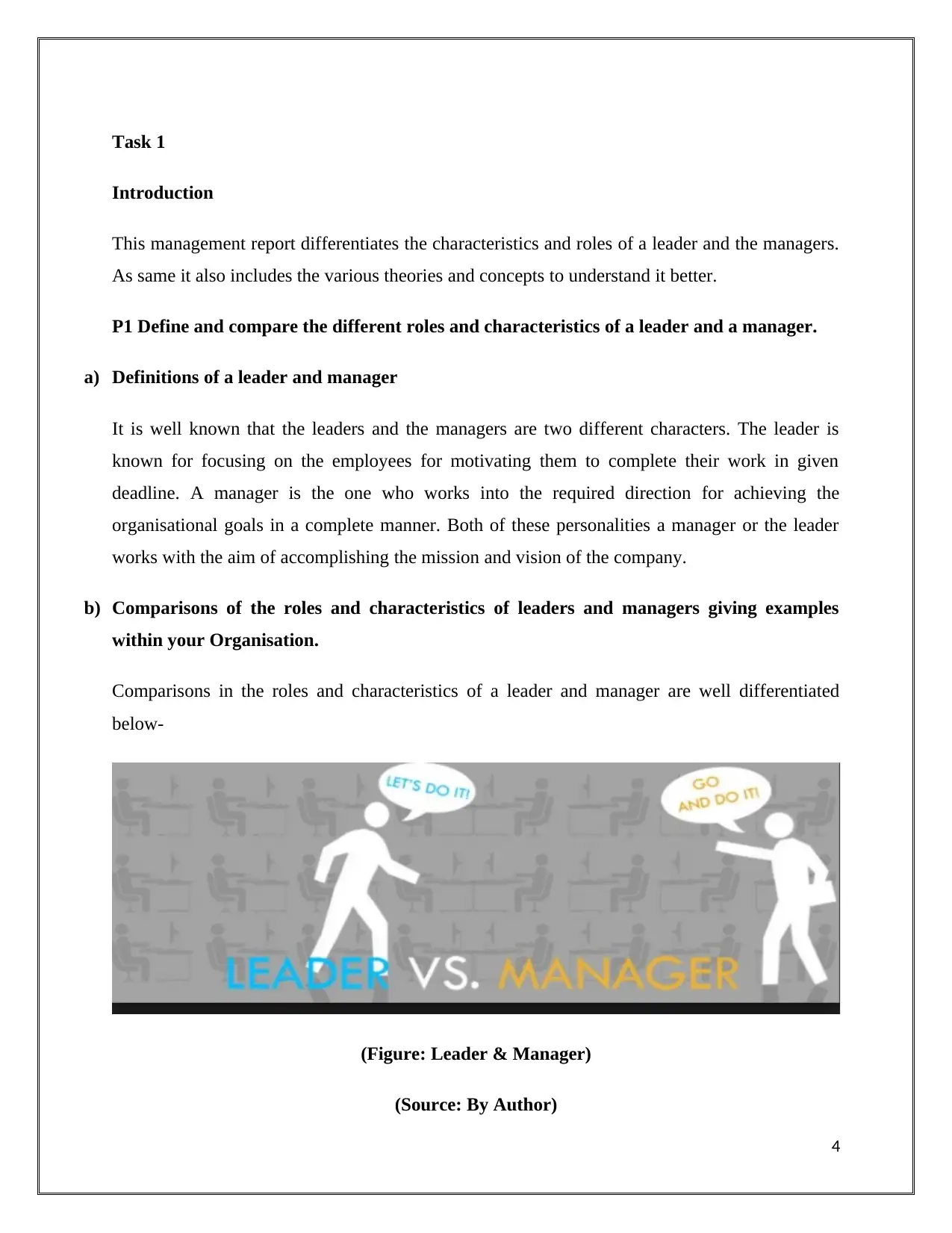
Task 1
Introduction
This management report differentiates the characteristics and roles of a leader and the managers.
As same it also includes the various theories and concepts to understand it better.
P1 Define and compare the different roles and characteristics of a leader and a manager.
a) Definitions of a leader and manager
It is well known that the leaders and the managers are two different characters. The leader is
known for focusing on the employees for motivating them to complete their work in given
deadline. A manager is the one who works into the required direction for achieving the
organisational goals in a complete manner. Both of these personalities a manager or the leader
works with the aim of accomplishing the mission and vision of the company.
b) Comparisons of the roles and characteristics of leaders and managers giving examples
within your Organisation.
Comparisons in the roles and characteristics of a leader and manager are well differentiated
below-
(Figure: Leader & Manager)
(Source: By Author)
4
Introduction
This management report differentiates the characteristics and roles of a leader and the managers.
As same it also includes the various theories and concepts to understand it better.
P1 Define and compare the different roles and characteristics of a leader and a manager.
a) Definitions of a leader and manager
It is well known that the leaders and the managers are two different characters. The leader is
known for focusing on the employees for motivating them to complete their work in given
deadline. A manager is the one who works into the required direction for achieving the
organisational goals in a complete manner. Both of these personalities a manager or the leader
works with the aim of accomplishing the mission and vision of the company.
b) Comparisons of the roles and characteristics of leaders and managers giving examples
within your Organisation.
Comparisons in the roles and characteristics of a leader and manager are well differentiated
below-
(Figure: Leader & Manager)
(Source: By Author)
4
Paraphrase This Document
Need a fresh take? Get an instant paraphrase of this document with our AI Paraphraser
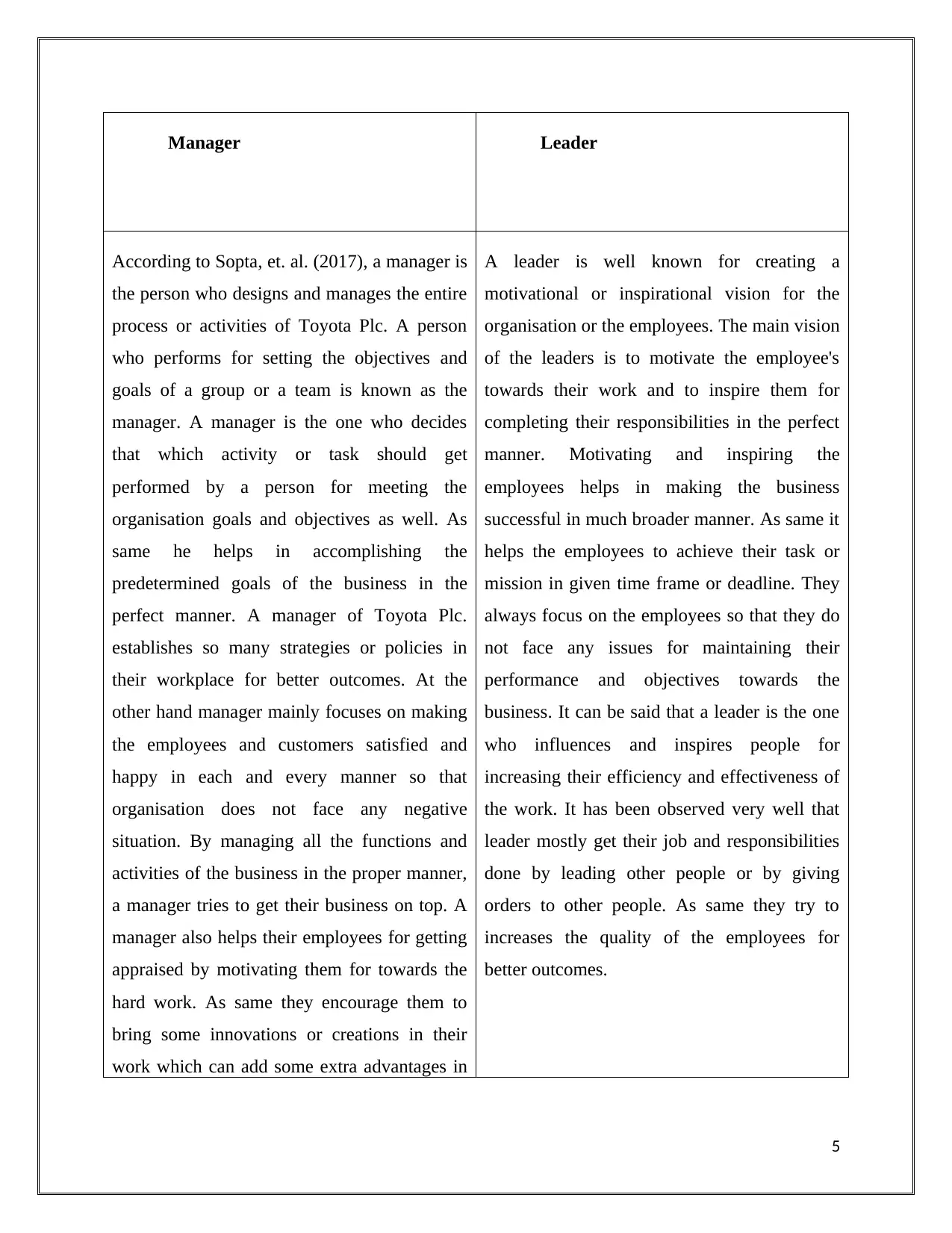
Manager Leader
According to Sopta, et. al. (2017), a manager is
the person who designs and manages the entire
process or activities of Toyota Plc. A person
who performs for setting the objectives and
goals of a group or a team is known as the
manager. A manager is the one who decides
that which activity or task should get
performed by a person for meeting the
organisation goals and objectives as well. As
same he helps in accomplishing the
predetermined goals of the business in the
perfect manner. A manager of Toyota Plc.
establishes so many strategies or policies in
their workplace for better outcomes. At the
other hand manager mainly focuses on making
the employees and customers satisfied and
happy in each and every manner so that
organisation does not face any negative
situation. By managing all the functions and
activities of the business in the proper manner,
a manager tries to get their business on top. A
manager also helps their employees for getting
appraised by motivating them for towards the
hard work. As same they encourage them to
bring some innovations or creations in their
work which can add some extra advantages in
A leader is well known for creating a
motivational or inspirational vision for the
organisation or the employees. The main vision
of the leaders is to motivate the employee's
towards their work and to inspire them for
completing their responsibilities in the perfect
manner. Motivating and inspiring the
employees helps in making the business
successful in much broader manner. As same it
helps the employees to achieve their task or
mission in given time frame or deadline. They
always focus on the employees so that they do
not face any issues for maintaining their
performance and objectives towards the
business. It can be said that a leader is the one
who influences and inspires people for
increasing their efficiency and effectiveness of
the work. It has been observed very well that
leader mostly get their job and responsibilities
done by leading other people or by giving
orders to other people. As same they try to
increases the quality of the employees for
better outcomes.
5
According to Sopta, et. al. (2017), a manager is
the person who designs and manages the entire
process or activities of Toyota Plc. A person
who performs for setting the objectives and
goals of a group or a team is known as the
manager. A manager is the one who decides
that which activity or task should get
performed by a person for meeting the
organisation goals and objectives as well. As
same he helps in accomplishing the
predetermined goals of the business in the
perfect manner. A manager of Toyota Plc.
establishes so many strategies or policies in
their workplace for better outcomes. At the
other hand manager mainly focuses on making
the employees and customers satisfied and
happy in each and every manner so that
organisation does not face any negative
situation. By managing all the functions and
activities of the business in the proper manner,
a manager tries to get their business on top. A
manager also helps their employees for getting
appraised by motivating them for towards the
hard work. As same they encourage them to
bring some innovations or creations in their
work which can add some extra advantages in
A leader is well known for creating a
motivational or inspirational vision for the
organisation or the employees. The main vision
of the leaders is to motivate the employee's
towards their work and to inspire them for
completing their responsibilities in the perfect
manner. Motivating and inspiring the
employees helps in making the business
successful in much broader manner. As same it
helps the employees to achieve their task or
mission in given time frame or deadline. They
always focus on the employees so that they do
not face any issues for maintaining their
performance and objectives towards the
business. It can be said that a leader is the one
who influences and inspires people for
increasing their efficiency and effectiveness of
the work. It has been observed very well that
leader mostly get their job and responsibilities
done by leading other people or by giving
orders to other people. As same they try to
increases the quality of the employees for
better outcomes.
5
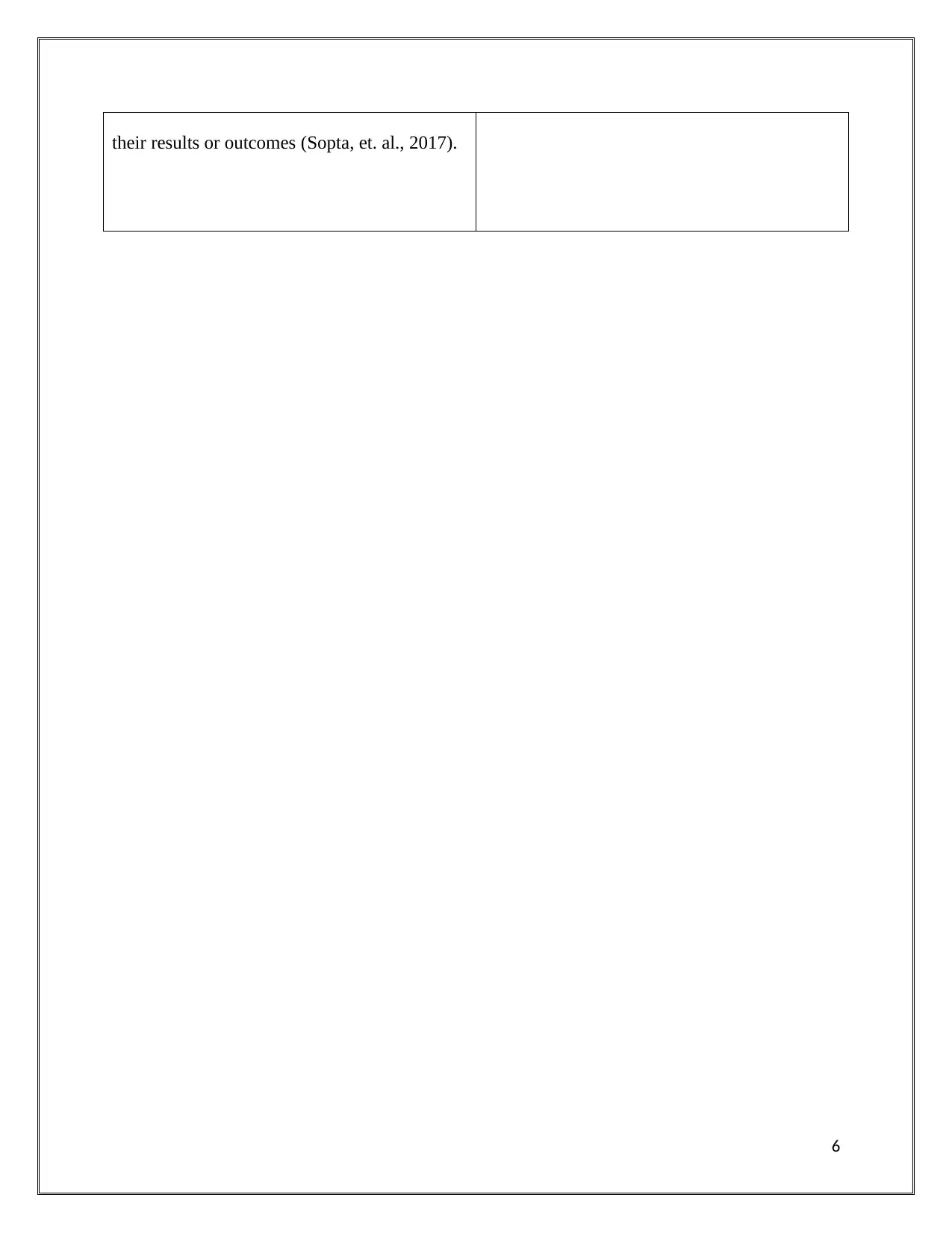
their results or outcomes (Sopta, et. al., 2017).
6
6
⊘ This is a preview!⊘
Do you want full access?
Subscribe today to unlock all pages.

Trusted by 1+ million students worldwide
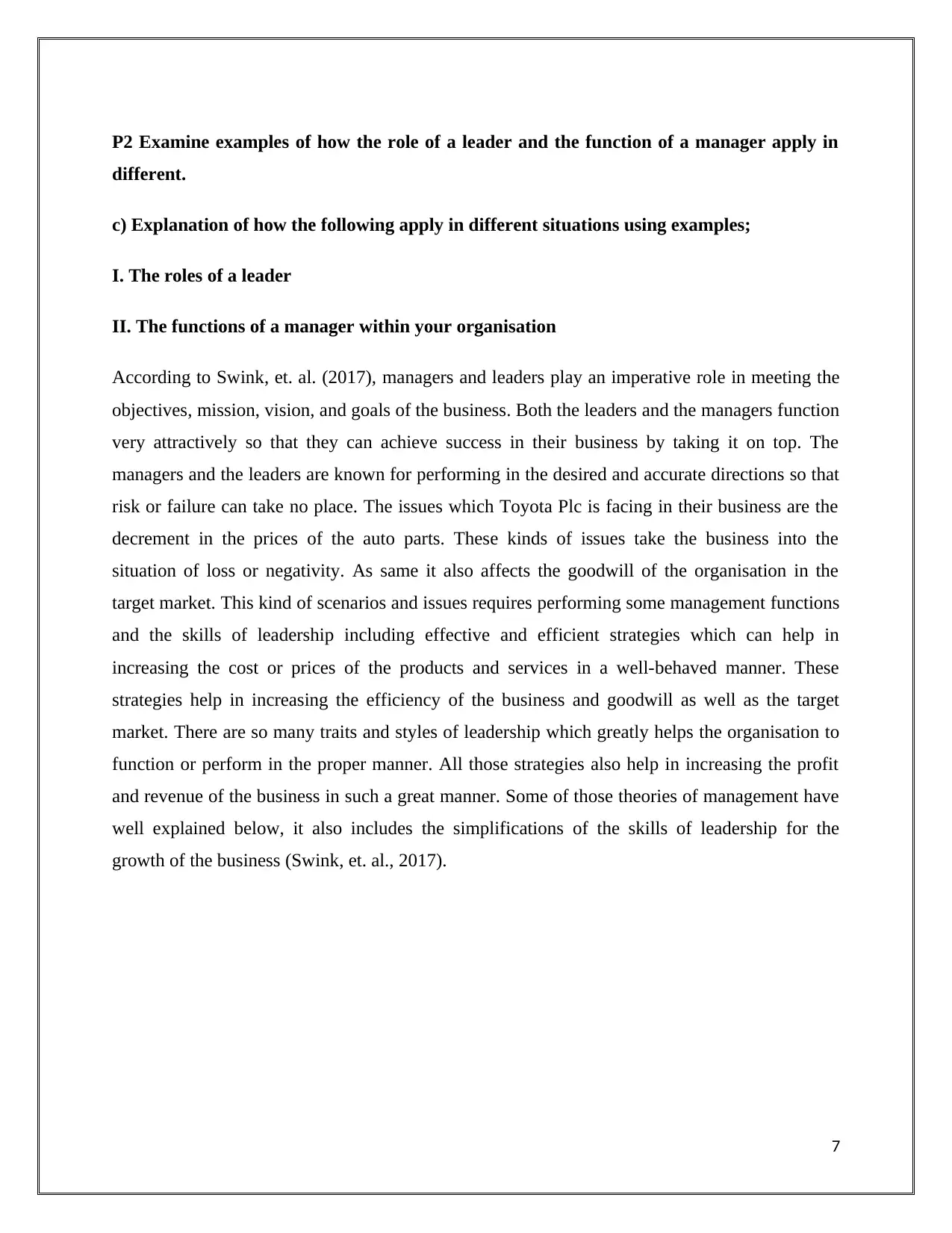
P2 Examine examples of how the role of a leader and the function of a manager apply in
different.
c) Explanation of how the following apply in different situations using examples;
I. The roles of a leader
II. The functions of a manager within your organisation
According to Swink, et. al. (2017), managers and leaders play an imperative role in meeting the
objectives, mission, vision, and goals of the business. Both the leaders and the managers function
very attractively so that they can achieve success in their business by taking it on top. The
managers and the leaders are known for performing in the desired and accurate directions so that
risk or failure can take no place. The issues which Toyota Plc is facing in their business are the
decrement in the prices of the auto parts. These kinds of issues take the business into the
situation of loss or negativity. As same it also affects the goodwill of the organisation in the
target market. This kind of scenarios and issues requires performing some management functions
and the skills of leadership including effective and efficient strategies which can help in
increasing the cost or prices of the products and services in a well-behaved manner. These
strategies help in increasing the efficiency of the business and goodwill as well as the target
market. There are so many traits and styles of leadership which greatly helps the organisation to
function or perform in the proper manner. All those strategies also help in increasing the profit
and revenue of the business in such a great manner. Some of those theories of management have
well explained below, it also includes the simplifications of the skills of leadership for the
growth of the business (Swink, et. al., 2017).
7
different.
c) Explanation of how the following apply in different situations using examples;
I. The roles of a leader
II. The functions of a manager within your organisation
According to Swink, et. al. (2017), managers and leaders play an imperative role in meeting the
objectives, mission, vision, and goals of the business. Both the leaders and the managers function
very attractively so that they can achieve success in their business by taking it on top. The
managers and the leaders are known for performing in the desired and accurate directions so that
risk or failure can take no place. The issues which Toyota Plc is facing in their business are the
decrement in the prices of the auto parts. These kinds of issues take the business into the
situation of loss or negativity. As same it also affects the goodwill of the organisation in the
target market. This kind of scenarios and issues requires performing some management functions
and the skills of leadership including effective and efficient strategies which can help in
increasing the cost or prices of the products and services in a well-behaved manner. These
strategies help in increasing the efficiency of the business and goodwill as well as the target
market. There are so many traits and styles of leadership which greatly helps the organisation to
function or perform in the proper manner. All those strategies also help in increasing the profit
and revenue of the business in such a great manner. Some of those theories of management have
well explained below, it also includes the simplifications of the skills of leadership for the
growth of the business (Swink, et. al., 2017).
7
Paraphrase This Document
Need a fresh take? Get an instant paraphrase of this document with our AI Paraphraser
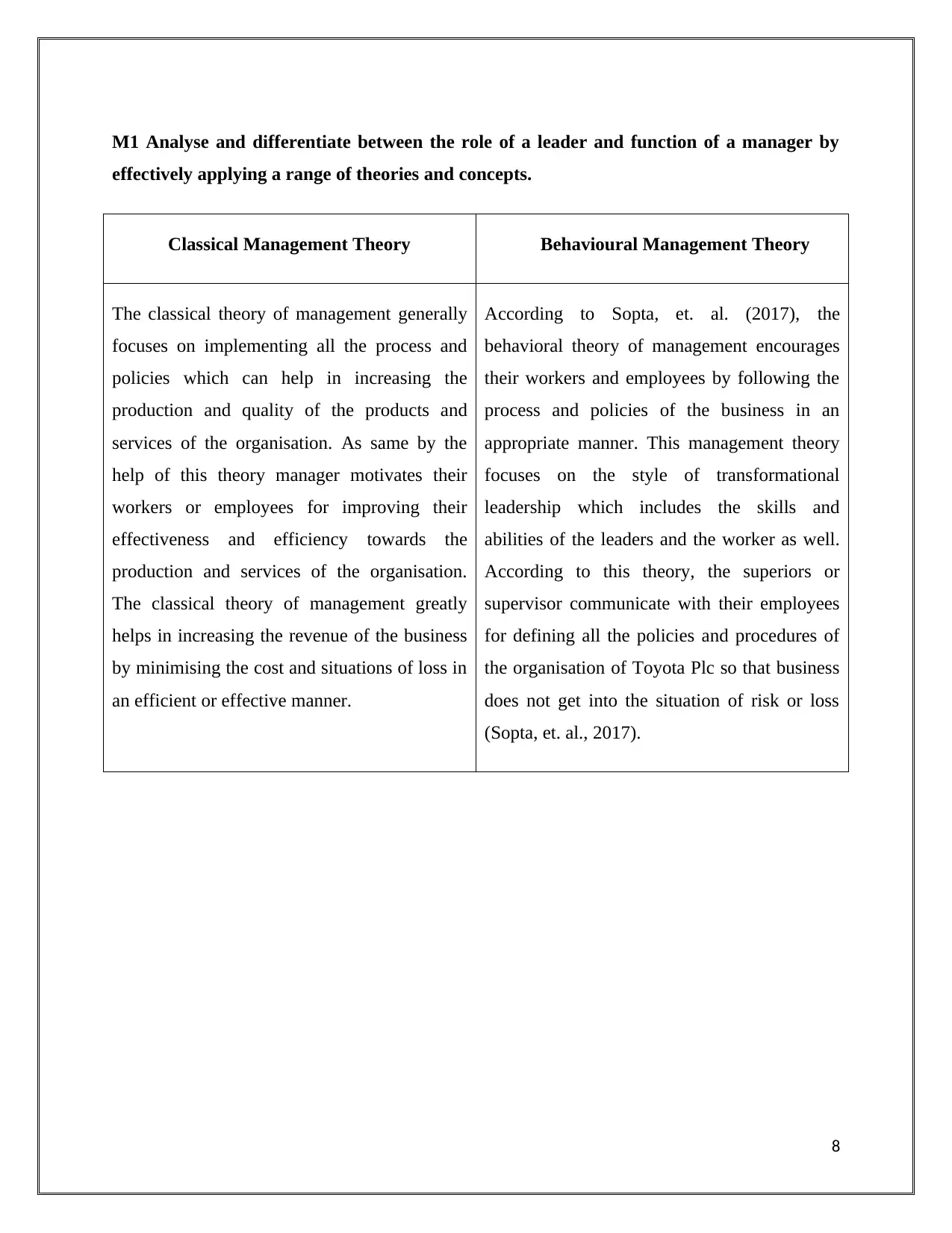
M1 Analyse and differentiate between the role of a leader and function of a manager by
effectively applying a range of theories and concepts.
Classical Management Theory Behavioural Management Theory
The classical theory of management generally
focuses on implementing all the process and
policies which can help in increasing the
production and quality of the products and
services of the organisation. As same by the
help of this theory manager motivates their
workers or employees for improving their
effectiveness and efficiency towards the
production and services of the organisation.
The classical theory of management greatly
helps in increasing the revenue of the business
by minimising the cost and situations of loss in
an efficient or effective manner.
According to Sopta, et. al. (2017), the
behavioral theory of management encourages
their workers and employees by following the
process and policies of the business in an
appropriate manner. This management theory
focuses on the style of transformational
leadership which includes the skills and
abilities of the leaders and the worker as well.
According to this theory, the superiors or
supervisor communicate with their employees
for defining all the policies and procedures of
the organisation of Toyota Plc so that business
does not get into the situation of risk or loss
(Sopta, et. al., 2017).
8
effectively applying a range of theories and concepts.
Classical Management Theory Behavioural Management Theory
The classical theory of management generally
focuses on implementing all the process and
policies which can help in increasing the
production and quality of the products and
services of the organisation. As same by the
help of this theory manager motivates their
workers or employees for improving their
effectiveness and efficiency towards the
production and services of the organisation.
The classical theory of management greatly
helps in increasing the revenue of the business
by minimising the cost and situations of loss in
an efficient or effective manner.
According to Sopta, et. al. (2017), the
behavioral theory of management encourages
their workers and employees by following the
process and policies of the business in an
appropriate manner. This management theory
focuses on the style of transformational
leadership which includes the skills and
abilities of the leaders and the worker as well.
According to this theory, the superiors or
supervisor communicate with their employees
for defining all the policies and procedures of
the organisation of Toyota Plc so that business
does not get into the situation of risk or loss
(Sopta, et. al., 2017).
8
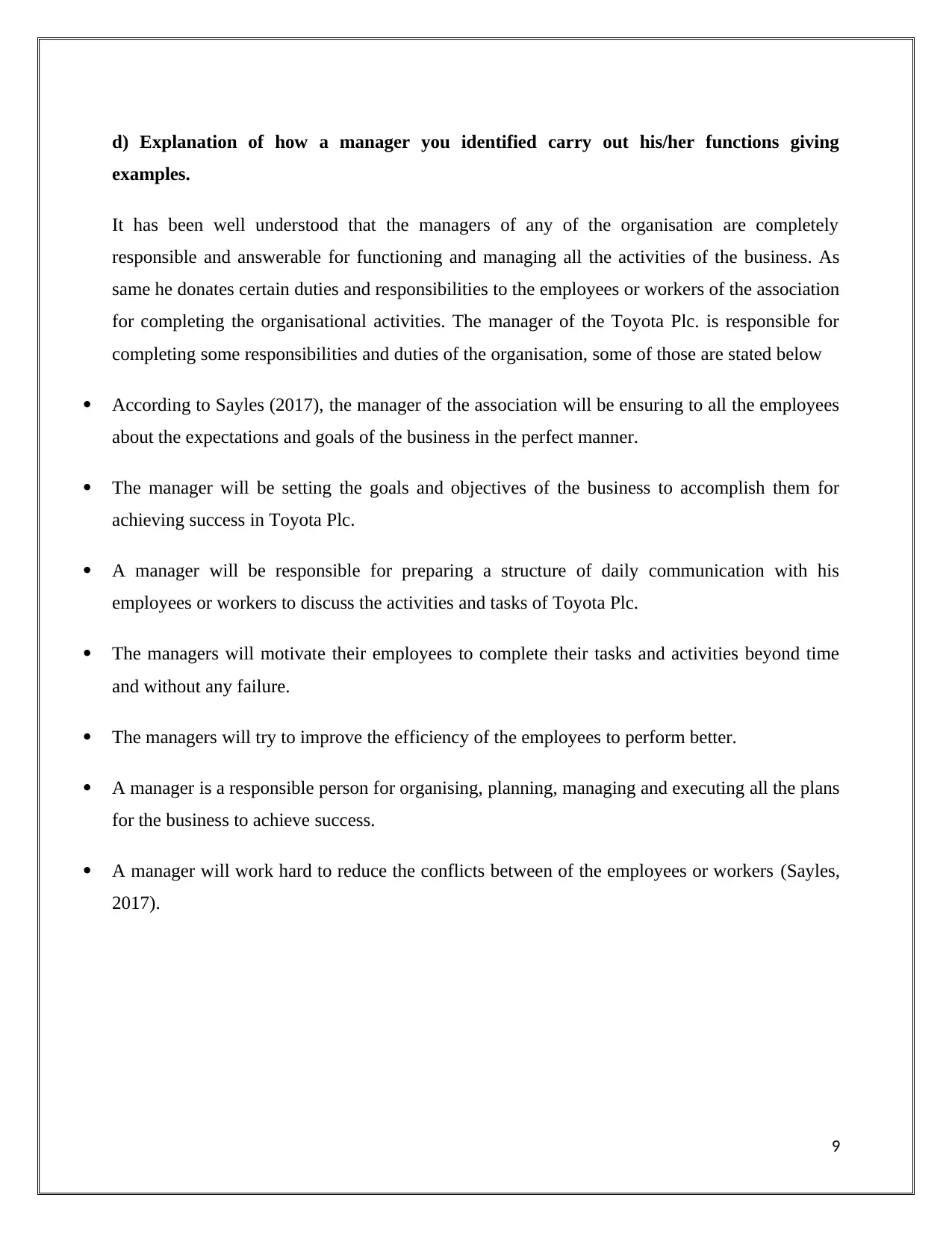
d) Explanation of how a manager you identified carry out his/her functions giving
examples.
It has been well understood that the managers of any of the organisation are completely
responsible and answerable for functioning and managing all the activities of the business. As
same he donates certain duties and responsibilities to the employees or workers of the association
for completing the organisational activities. The manager of the Toyota Plc. is responsible for
completing some responsibilities and duties of the organisation, some of those are stated below
According to Sayles (2017), the manager of the association will be ensuring to all the employees
about the expectations and goals of the business in the perfect manner.
The manager will be setting the goals and objectives of the business to accomplish them for
achieving success in Toyota Plc.
A manager will be responsible for preparing a structure of daily communication with his
employees or workers to discuss the activities and tasks of Toyota Plc.
The managers will motivate their employees to complete their tasks and activities beyond time
and without any failure.
The managers will try to improve the efficiency of the employees to perform better.
A manager is a responsible person for organising, planning, managing and executing all the plans
for the business to achieve success.
A manager will work hard to reduce the conflicts between of the employees or workers (Sayles,
2017).
9
examples.
It has been well understood that the managers of any of the organisation are completely
responsible and answerable for functioning and managing all the activities of the business. As
same he donates certain duties and responsibilities to the employees or workers of the association
for completing the organisational activities. The manager of the Toyota Plc. is responsible for
completing some responsibilities and duties of the organisation, some of those are stated below
According to Sayles (2017), the manager of the association will be ensuring to all the employees
about the expectations and goals of the business in the perfect manner.
The manager will be setting the goals and objectives of the business to accomplish them for
achieving success in Toyota Plc.
A manager will be responsible for preparing a structure of daily communication with his
employees or workers to discuss the activities and tasks of Toyota Plc.
The managers will motivate their employees to complete their tasks and activities beyond time
and without any failure.
The managers will try to improve the efficiency of the employees to perform better.
A manager is a responsible person for organising, planning, managing and executing all the plans
for the business to achieve success.
A manager will work hard to reduce the conflicts between of the employees or workers (Sayles,
2017).
9
⊘ This is a preview!⊘
Do you want full access?
Subscribe today to unlock all pages.

Trusted by 1+ million students worldwide
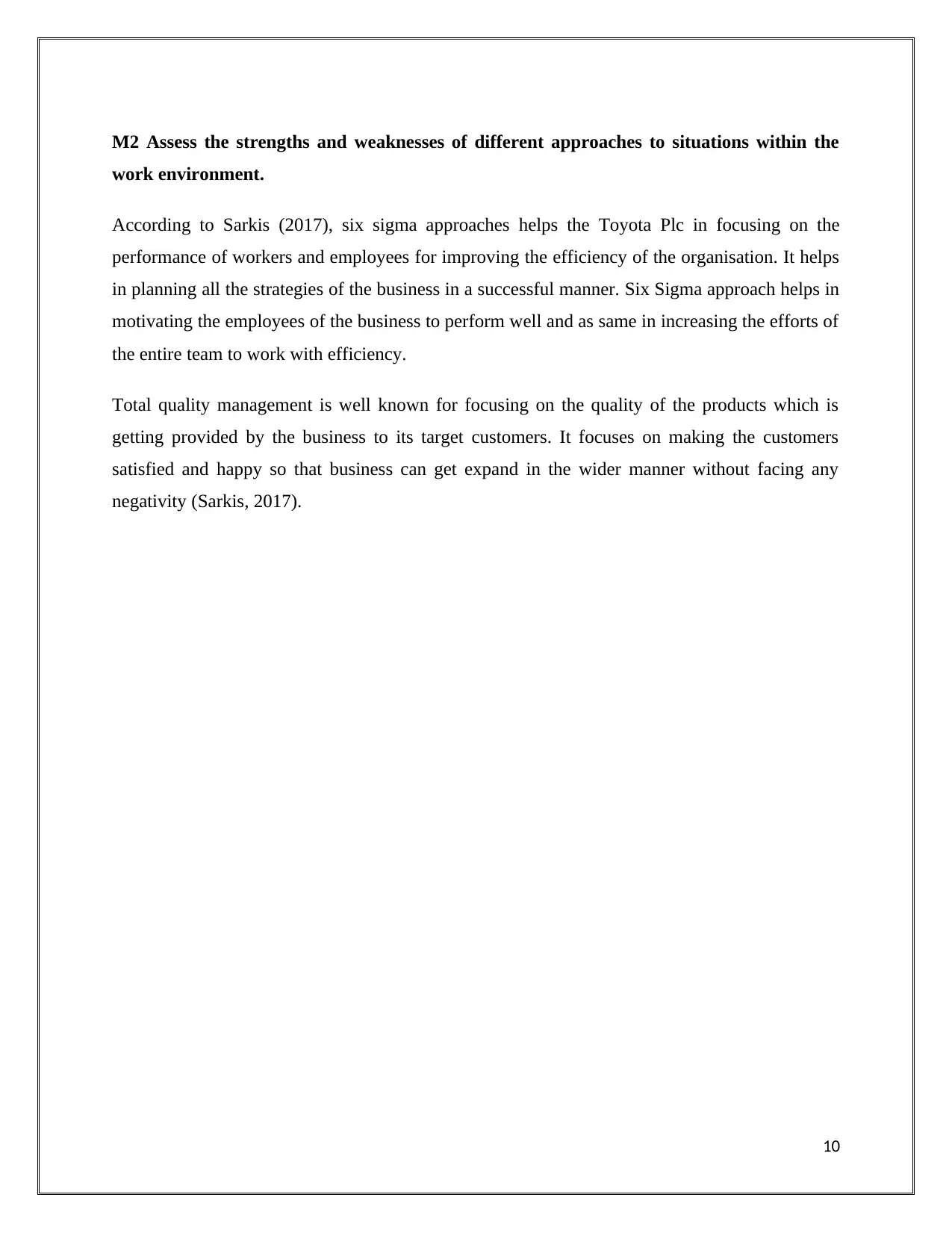
M2 Assess the strengths and weaknesses of different approaches to situations within the
work environment.
According to Sarkis (2017), six sigma approaches helps the Toyota Plc in focusing on the
performance of workers and employees for improving the efficiency of the organisation. It helps
in planning all the strategies of the business in a successful manner. Six Sigma approach helps in
motivating the employees of the business to perform well and as same in increasing the efforts of
the entire team to work with efficiency.
Total quality management is well known for focusing on the quality of the products which is
getting provided by the business to its target customers. It focuses on making the customers
satisfied and happy so that business can get expand in the wider manner without facing any
negativity (Sarkis, 2017).
10
work environment.
According to Sarkis (2017), six sigma approaches helps the Toyota Plc in focusing on the
performance of workers and employees for improving the efficiency of the organisation. It helps
in planning all the strategies of the business in a successful manner. Six Sigma approach helps in
motivating the employees of the business to perform well and as same in increasing the efforts of
the entire team to work with efficiency.
Total quality management is well known for focusing on the quality of the products which is
getting provided by the business to its target customers. It focuses on making the customers
satisfied and happy so that business can get expand in the wider manner without facing any
negativity (Sarkis, 2017).
10
Paraphrase This Document
Need a fresh take? Get an instant paraphrase of this document with our AI Paraphraser
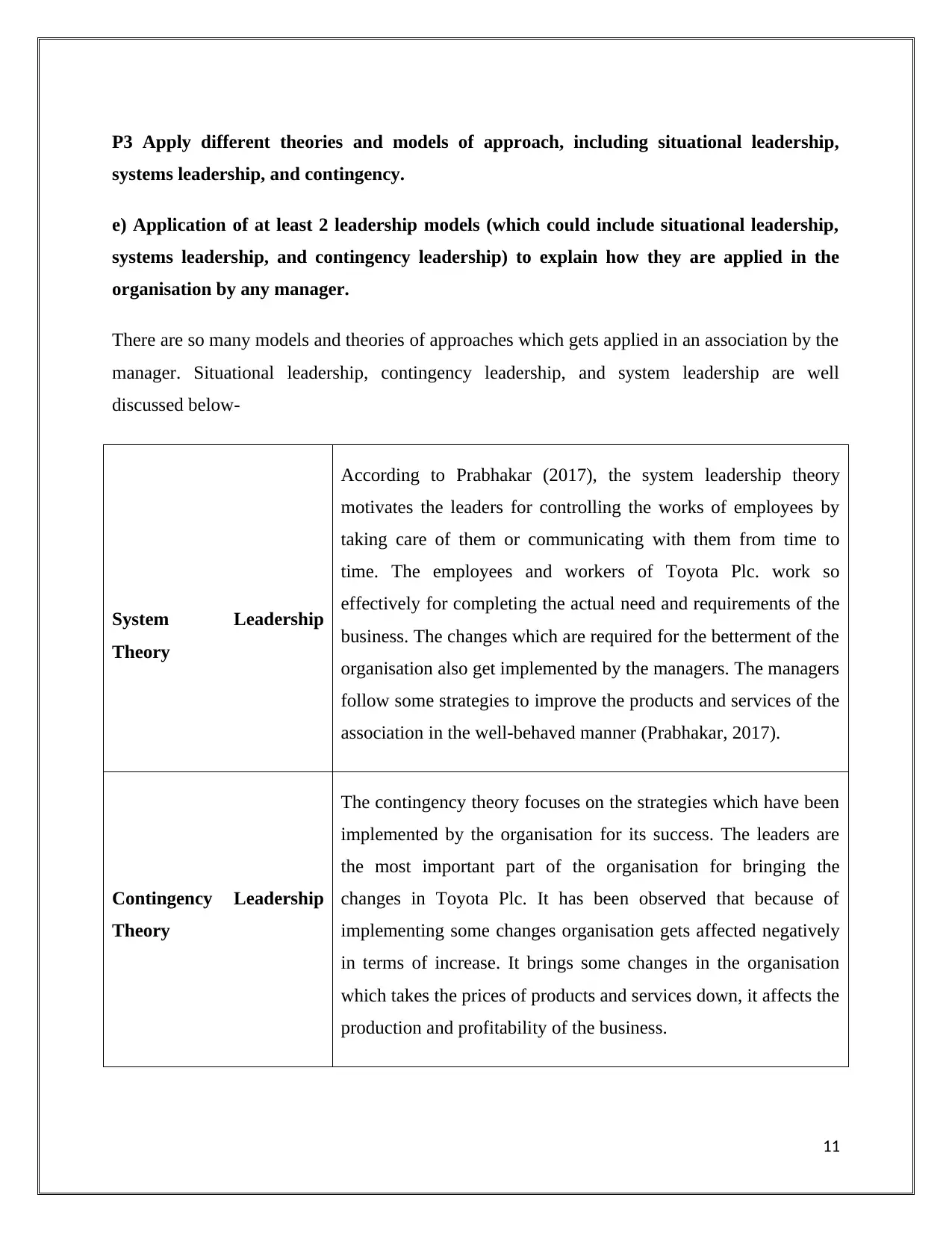
P3 Apply different theories and models of approach, including situational leadership,
systems leadership, and contingency.
e) Application of at least 2 leadership models (which could include situational leadership,
systems leadership, and contingency leadership) to explain how they are applied in the
organisation by any manager.
There are so many models and theories of approaches which gets applied in an association by the
manager. Situational leadership, contingency leadership, and system leadership are well
discussed below-
System Leadership
Theory
According to Prabhakar (2017), the system leadership theory
motivates the leaders for controlling the works of employees by
taking care of them or communicating with them from time to
time. The employees and workers of Toyota Plc. work so
effectively for completing the actual need and requirements of the
business. The changes which are required for the betterment of the
organisation also get implemented by the managers. The managers
follow some strategies to improve the products and services of the
association in the well-behaved manner (Prabhakar, 2017).
Contingency Leadership
Theory
The contingency theory focuses on the strategies which have been
implemented by the organisation for its success. The leaders are
the most important part of the organisation for bringing the
changes in Toyota Plc. It has been observed that because of
implementing some changes organisation gets affected negatively
in terms of increase. It brings some changes in the organisation
which takes the prices of products and services down, it affects the
production and profitability of the business.
11
systems leadership, and contingency.
e) Application of at least 2 leadership models (which could include situational leadership,
systems leadership, and contingency leadership) to explain how they are applied in the
organisation by any manager.
There are so many models and theories of approaches which gets applied in an association by the
manager. Situational leadership, contingency leadership, and system leadership are well
discussed below-
System Leadership
Theory
According to Prabhakar (2017), the system leadership theory
motivates the leaders for controlling the works of employees by
taking care of them or communicating with them from time to
time. The employees and workers of Toyota Plc. work so
effectively for completing the actual need and requirements of the
business. The changes which are required for the betterment of the
organisation also get implemented by the managers. The managers
follow some strategies to improve the products and services of the
association in the well-behaved manner (Prabhakar, 2017).
Contingency Leadership
Theory
The contingency theory focuses on the strategies which have been
implemented by the organisation for its success. The leaders are
the most important part of the organisation for bringing the
changes in Toyota Plc. It has been observed that because of
implementing some changes organisation gets affected negatively
in terms of increase. It brings some changes in the organisation
which takes the prices of products and services down, it affects the
production and profitability of the business.
11
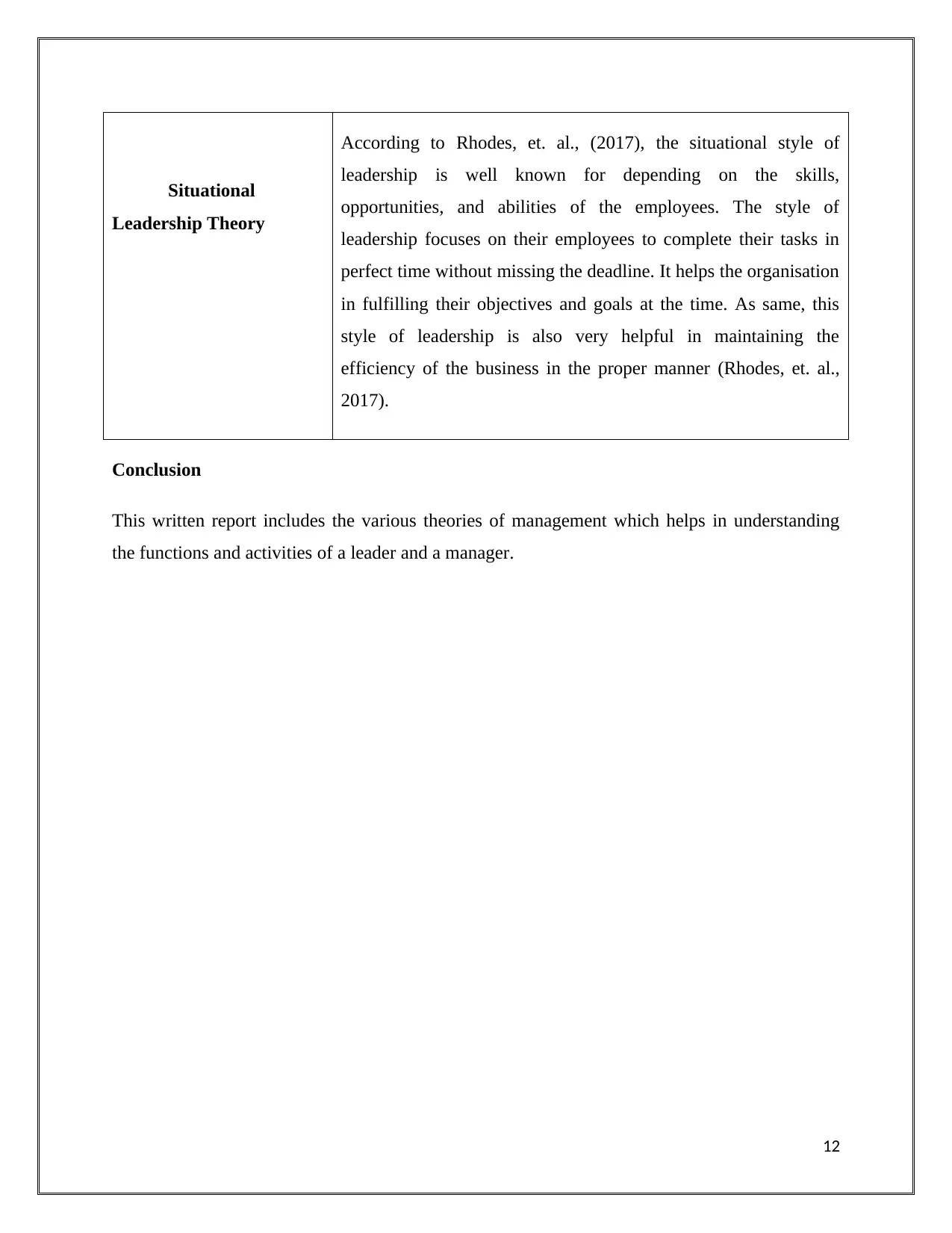
Situational
Leadership Theory
According to Rhodes, et. al., (2017), the situational style of
leadership is well known for depending on the skills,
opportunities, and abilities of the employees. The style of
leadership focuses on their employees to complete their tasks in
perfect time without missing the deadline. It helps the organisation
in fulfilling their objectives and goals at the time. As same, this
style of leadership is also very helpful in maintaining the
efficiency of the business in the proper manner (Rhodes, et. al.,
2017).
Conclusion
This written report includes the various theories of management which helps in understanding
the functions and activities of a leader and a manager.
12
Leadership Theory
According to Rhodes, et. al., (2017), the situational style of
leadership is well known for depending on the skills,
opportunities, and abilities of the employees. The style of
leadership focuses on their employees to complete their tasks in
perfect time without missing the deadline. It helps the organisation
in fulfilling their objectives and goals at the time. As same, this
style of leadership is also very helpful in maintaining the
efficiency of the business in the proper manner (Rhodes, et. al.,
2017).
Conclusion
This written report includes the various theories of management which helps in understanding
the functions and activities of a leader and a manager.
12
⊘ This is a preview!⊘
Do you want full access?
Subscribe today to unlock all pages.

Trusted by 1+ million students worldwide
1 out of 25
Related Documents
Your All-in-One AI-Powered Toolkit for Academic Success.
+13062052269
info@desklib.com
Available 24*7 on WhatsApp / Email
![[object Object]](/_next/static/media/star-bottom.7253800d.svg)
Unlock your academic potential
Copyright © 2020–2025 A2Z Services. All Rights Reserved. Developed and managed by ZUCOL.




